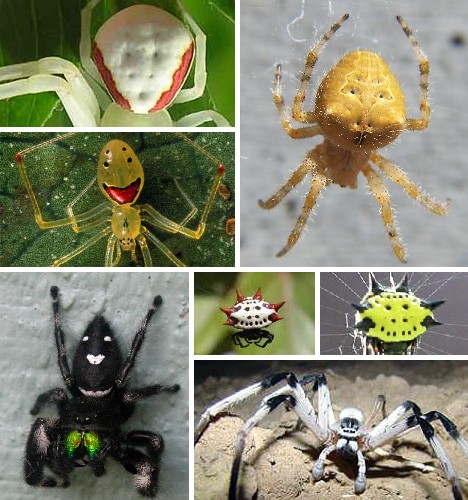
Spiders who show off smile-like markings are much more than Internet memes and they’re not here to make you laugh, either. Just the opposite: these spiders’ bold faces serve to scare and confuse potential predators. Happy now?
![]()
Cat-Faced Spider
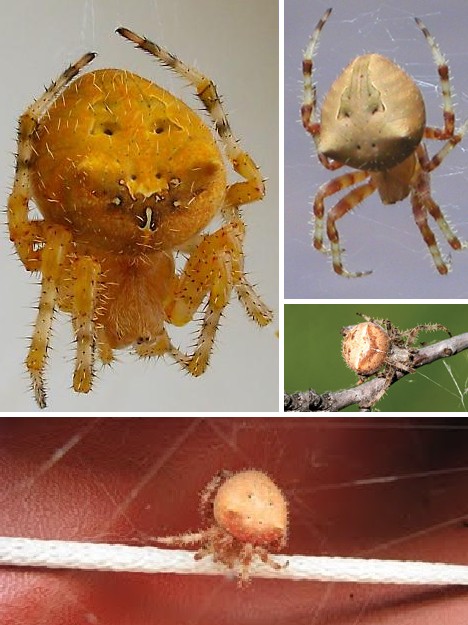 (images via: CSU CoopExt and BugGuide)
(images via: CSU CoopExt and BugGuide)
The Cat-Faced Spider (Araneus gemmoides) is an orb weaver spider found in the American west and Pacific northwest. Often found around houses in areas lit by artificial lighting at night, cat-faced spiders may look somewhat creepy but they’re not poisonous.
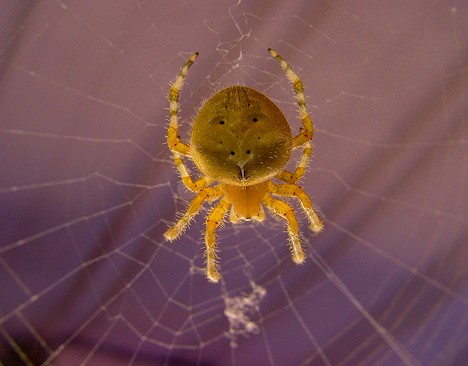 (image via: Tocayo750)
(image via: Tocayo750)
Cat-Faced Spiders are rather small; only about 1/5 of an inch wide, and the females are much larger than the males. They may display light or dark forms though the “face” stands out more on the lighter, straw-colored variants. I can haz fliez?
![]()
Spinybacked Orbweaver Spider
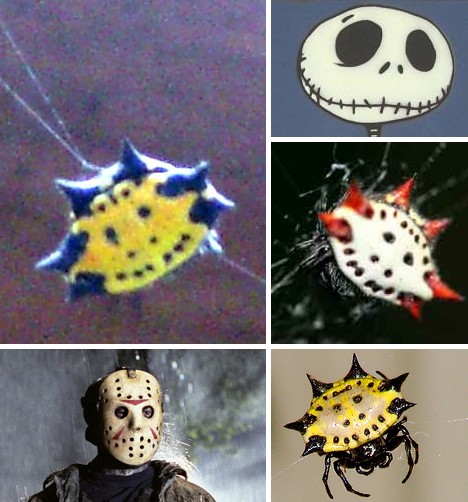
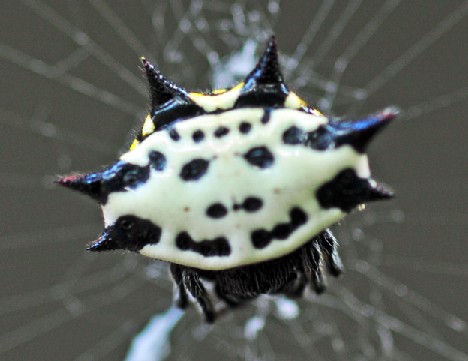 (images via: BugGuide, What’s That Bug?, Islandmom and Dan Poore)
(images via: BugGuide, What’s That Bug?, Islandmom and Dan Poore)
The Spinybacked Orbweaver (Gasteracantha cancriformis) can’t seem to decide if it wants to be Jason Voorhees from the Friday the 13th slasher films or Jack Skellington from The Nightmare Before Christmas. Let’s hope it makes up its mind soon – this transitional form is way freaky.
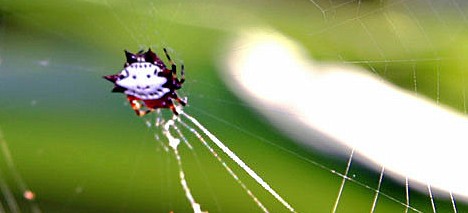
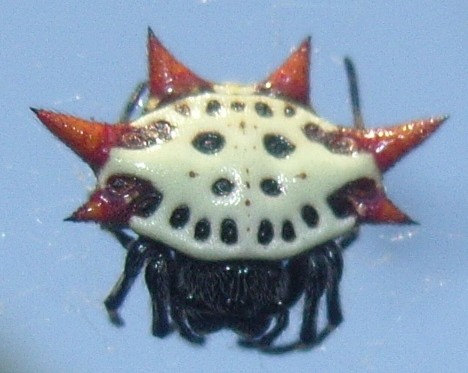 (images via: Roberta Davidson and Gojeffrey)
(images via: Roberta Davidson and Gojeffrey)
Spinybacked Orbweaver Spiders come in several different contrasting color combinations which allows them to play goalie for a number of IHL (Insect Hockey League) teams.
![]()
Cerbalus Aravensis
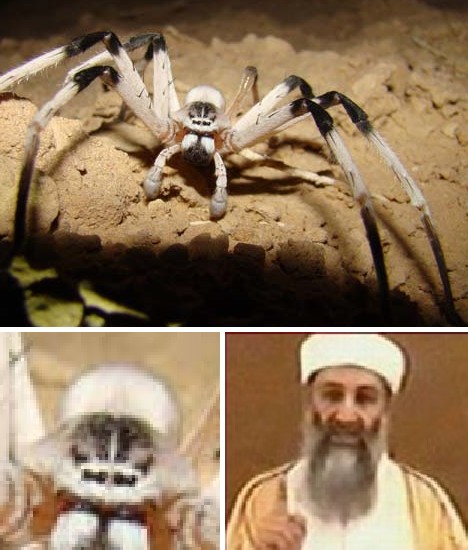 (images via: Wired Science and RainbowWarrior2005)
(images via: Wired Science and RainbowWarrior2005)
Cerbalus Aravensis is a frighteningly large spider with a 5.5 inches legspan that lives in and around the sand dunes on the Israel-Jordan border. From certain angles, Cerbalus Aravensis’ head and body resemble the face of an elderly tribesman who might live in that area of the middle east. Like, in a cave or something.
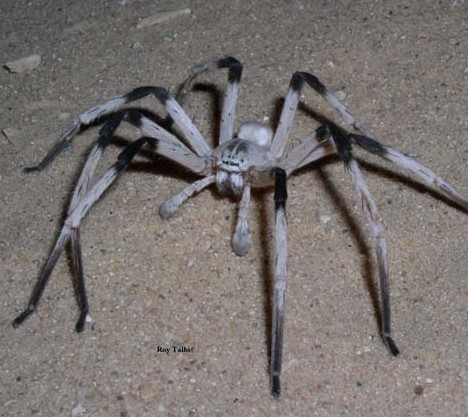 (image via: National Geographic)
(image via: National Geographic)
Biologist Uri Shanas of the University of Haifa-Oranim in Israel discovered the arachnid, hopefully not in a dark room while reaching for his towel. Said Shanas, “It is rare to find a new species of spider – at least around this part of the world – which is so big.” You’re next, Osama.
![]()
Bold Jumping Spider
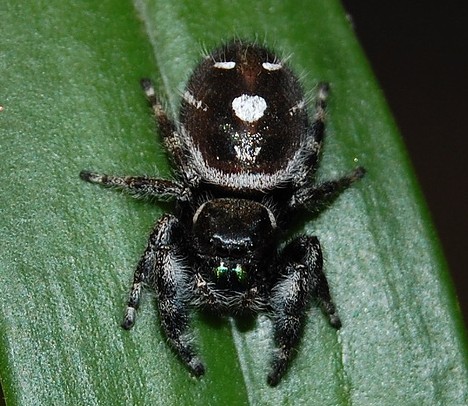
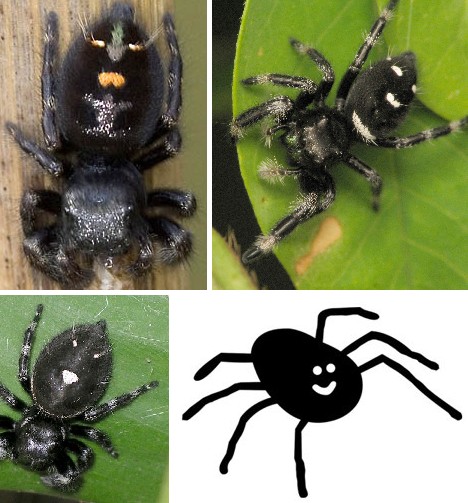 (images via: Stephen Cresswell, Ardradevir and Hartman Prehistoric Garden)
(images via: Stephen Cresswell, Ardradevir and Hartman Prehistoric Garden)
The Bold Jumping Spider (Phidippus audax) isn’t so much bold as it is, well, distinctive. Aha, but that’s just what they WANT you to think… while you’re smirking with amusement at the cartoonish white-on-black clownface decorating Phidippus’s posterior, a massive set of metallic blue-green fang-tipped chelicerae close in for the killing blow. Well, don’t worry too much, Phidippus audax is large for a Jumping Spider but its legspan is less than the diameter of a penny.
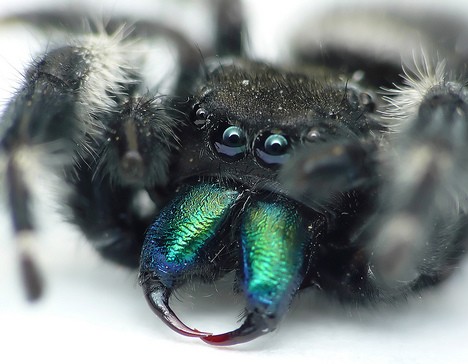 (image via: Salamandrella)
(image via: Salamandrella)
Be nice to any Bold Jumping Spiders you may see in and around your home – they’re harmless to humans but are hell on other bugs. Plus, they’ve been known to ward off the occasional bill collector, even with just seven legs.
![]()
Venusta Orchard Spider
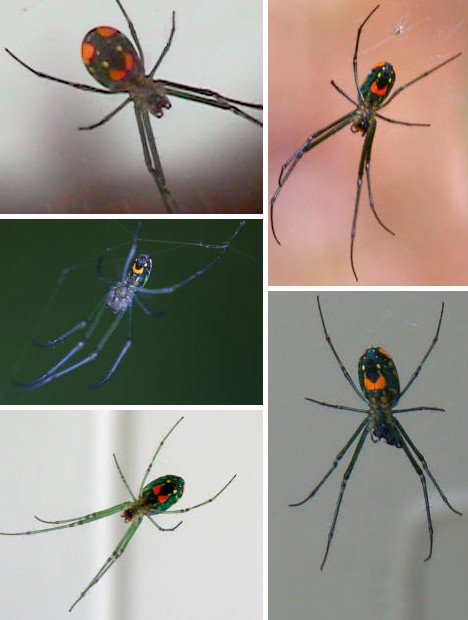 (image via: Spiderzrule)
(image via: Spiderzrule)
The Orchard Spider (Leucauge venusta) is commonly found along the American east coast, and not just in orchards. This is a large and varied group of spiders and they sport a wide variety of different abdominal markings. The Venusta Orchard Spiders pictured display eye & mouth spots that range in hue from vivid red through orange and yellow to light green.
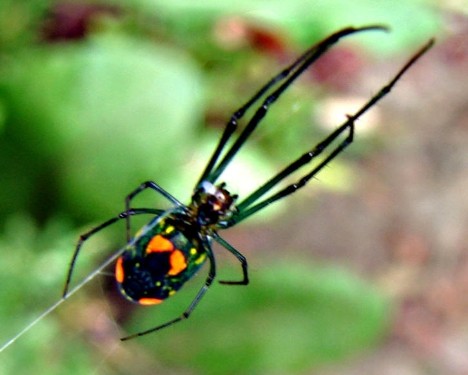 (image via: Webanswers)
(image via: Webanswers)
Often mistaken for Black Widow spiders or the similar (and also dangerous) Brown Widow, Venusta Orchard Spiders are not harmful and if left alone, will remain as happy as they appear.
![]()
Golden Silk Spider
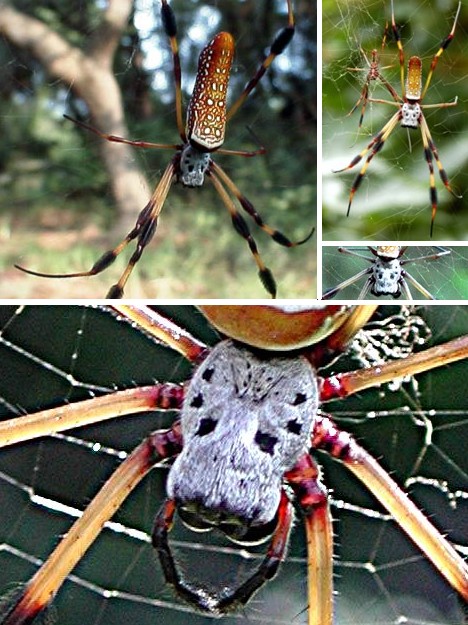 (images via: Nick’s Spiders, Edupic and Frank Starmer/IT Lab)
(images via: Nick’s Spiders, Edupic and Frank Starmer/IT Lab)
What spins a web a yard wide and looks like an eight-legged human skull? Your worst nightmare, yes, but also the Golden Silk Spider (Nephila clavipes). Forget about goofy happy faces, this guy means business. Also known as Calico Spiders, these bad boys don’t bother with using their bloated abdomens to show threatening patterns, their skull-like heads are quite fearsome enough in their own right, thank you very much.
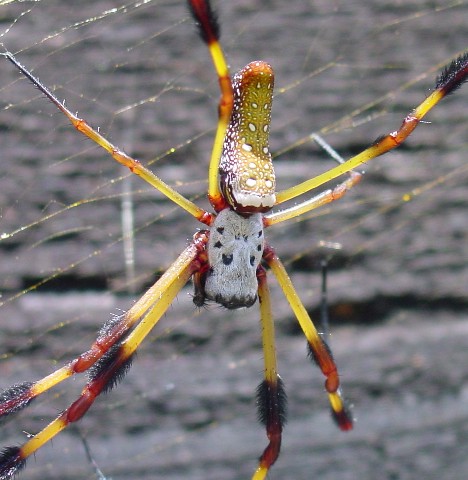 (image via: Shady Grove Training Center)
(image via: Shady Grove Training Center)
A native of Florida and the American southeast, the golden silk spider is one of the country’s largest orb-weaver spiders. Females can be up to 1.5 inches (40mm) long, which doesn’t seem so big until you factor in the legspan – about the width of a small dinner plate.
![]()
Goldenrod Crab Spider
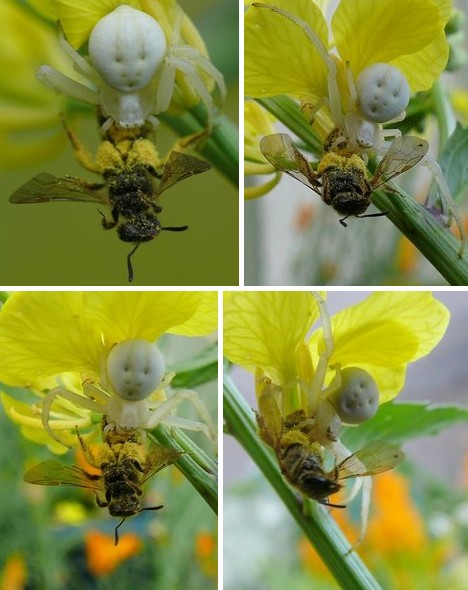 (image via: Nature Canada Blog)
(image via: Nature Canada Blog)
The Goldenrod Crab Spider may be small but like other members of its family, it makes up for what it lacks in size with stealth, speed, camouflage and the odd freaky face – speaking of which, check out the set of images above. Somewhat reminiscent of the climactic scene from the original 1958 film version of The Fly, these shots of a Goldenrod Crab Spider (Misumena vatia) giving a wayward bee the kiss of death are even creepier, if that’s possible.
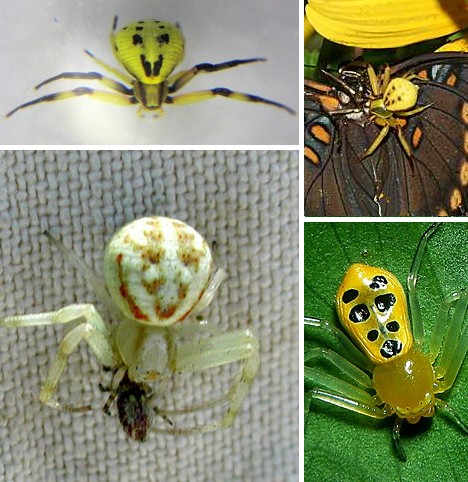
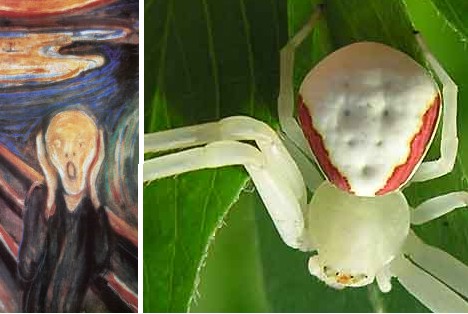 (images via: Arizonensis, Duke U and Magickcanoe)
(images via: Arizonensis, Duke U and Magickcanoe)
The snowy white Goldenrod Crab Spider above unintentionally uses its ghostly “face” and a pair of its legs to approximate the famous Edvard Munch painting, The Scream… appropriate, no?
![]()
Hawaiian Happy Face Spider
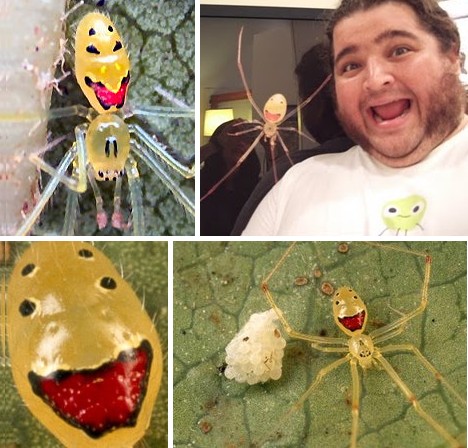 (images via: The Nature Conservancy and Corral.net Forums)
(images via: The Nature Conservancy and Corral.net Forums)
Spiders don’t make most people feel all warm & fuzzy.. maybe because they’re just too warm & fuzzy, but not in a good way. Not so the Happy Face Spider (Theridion grallator), found in the Hawaiian islands. When asked to comment on this tiny arachnid, Dr Geoff Oxford (a spider expert from the UK’s University of York) said: “I must admit when I turned over the first leaf and saw one it certainly brought a smile to my face.” Not the reaction the Happy Face Spider was seeking, perhaps, but at least Oxford didn’t eat it.
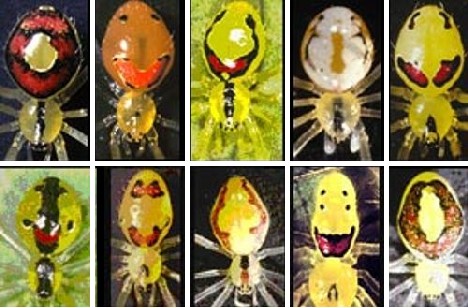 (image via: Impact Lab)
(image via: Impact Lab)
Theridion grallator can display a wide range of contrasting abdominal markings that vary from one individual to another, indicating that contrast is the point and not the “smile” we humans find so captivating.
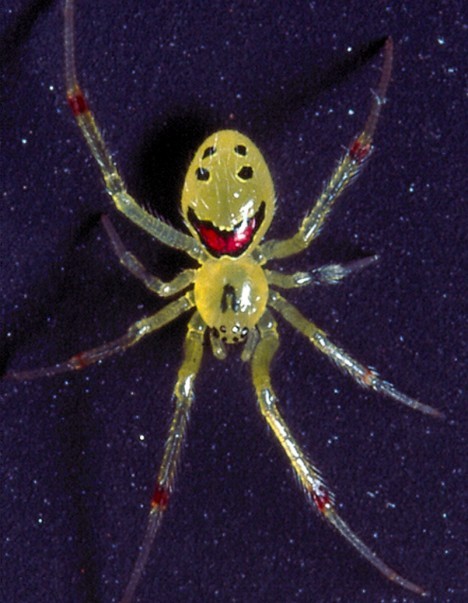 (image via: Daily Mail UK)
(image via: Daily Mail UK)
The Happy Face Spider is considered to be endangered as it’s only found in Hawaii and like so many other wild creatures, is threatened by encroachment by humans and the resulting loss of its preferred habitat. It would be sad indeed if the Happy Face Spider (and its charismatic cousins) should smile no more.







